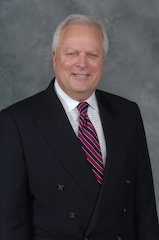One of the most fascinating planning areas in the spectrum of market niches is exit planning. Often times, in this area the advisor’s client will be the owner or owners of a closely held or family business. As he, she, or they look to exit the business, there are typically a tremendous number of issues to consider, and the dynamics of each business owner’s situation are almost always unique.
To look at the range of considerations when working in this market, I turned to two of the finest advisors in exit planning to talk about their businesses and how they operate. I spoke with Michael L. Weintraub, CLU, (pictured at right) of Walnut Creek, Calif., and James J. Tyrpak, MSFS, CLU, ChFC, AEP, (pictured next page) of Williamsville, N.Y., for their perspectives.
Last week, Part I of this article addressed how both experts got into exit planning, how they start the exit planning conversation with clients, and how to effectively work within a team of the client’s advisors on the process. In Part II, we’ll further explore the team dynamics, as well as best and most challenging aspects of this market before concluding with advice for those interested in breaking into this advanced market.
The agent’s place at the table
Along the lines of specialization, I asked about the strengths and value that the life insurance advisor brings to the table. In other words, why is it so crucial that the client include the life insurance advisor in the dialogue?
“Nothing is easy anymore,” Mr. Weintraub told me. “Attorneys know less about taxes, and accountants know less about legal matters, and fewer professionals know much about insurance, benefits, and investments than ever before. There is so much to know about one’s own specialty that it is no longer reasonable to expect others who are not in benefits, insurance, and investments to be able to give good, competent advice in areas in which they are not keeping up with all the changes. When an acquisition or sale of a business happens, someone needs to provide advice on liability tail coverage, merger or termination of retirement plans, what to do with key person life insurance, etc., so that the need for what we do is as important as what the others on the team provide.”
For Mr. Tyrpak, an important part of the life insurance advisor’s role is to get the client to move beyond evaluation and to move into action. “We feel that our training helps us take a role that will often help a client take action rather than contemplate the options. Our firm has generations of client experience, sometimes working with the third generation of ownership on their plans. We believe that these experiences and the fact that we can coordinate the transition of asset values into the owner’s personal holdings after the transition helps bring very important components to the plan.”
Best part about exit planning
It’s clear from their success and the enthusiastic way that these two advisors talk about their businesses that they truly enjoy their work in exit planning. So naturally, I asked about what they find to be the best parts of working in this market.
“This market presents opportunities to work with some very successful business owners and their talented advisory teams,” Mr. Tyrpak said. “There are no cookie-cutter solutions for implementing a plan. Utilizing ideas from experience with other companies and seeing the nuances of the current company that you are working with is both rewarding and fun.”
Mr. Weintraub told me, “It’s the culmination of what we do for clients while they are building and growing their companies. Not only is this a happy time for our client, but we get great satisfaction in knowing that along the way we helped them get want they wanted and that they worked so hard to get for their lifetime of work and risk taking.”
Hardest thing about exit planning
And on the flip side, I asked, what’s the most difficult or challenging aspect of the market? For Mr. Weintraub, that question brought him back to the advisory team. “Sometimes the team of advisors put together by the client is incompatible with one another,” he said. “This creates conflicts such that there may be times that we should hold our ground if we know another advisor is going down the wrong path with the client.”
For Mr. Tyrpak, the biggest challenge is that this market requires more patience than most. “This is a difficult market to work because it requires a lot of patience. Funding a buy-sell agreement with term insurance initially can be a great deal of work that results in a small payout in the beginning. In the individual insurance market, the client could buy the same levels of coverage with much less effort from the client’s and the advisor’s standpoint.”
Advice for getting into exit planning
These two advisors are both very experienced, so I asked about the advice they might give to the advisor considering getting into this market. Mr. Tyrpak responded by coming back to a familiar theme, “Be patient. This is a market that takes a long time to cultivate. Develop as many relationships with other advisors who can become advocates for your recommendations.”
Mr. Weintraub cautioned about entering the market at too young of an age. “This is generally a market for older, more mature advisors because the clients are older. When I tried doing this many years ago, I found that older business owners preferred to work with those closer to their age who have had similar experience and speak the same language. This could be a good team sport in which a younger advisor brings in someone to partner with to make the transaction work better.”
When I opened the door for final comments or closing thoughts, Mr. Tyrpak spoke up. “In this market,” he said, “you need to recognize with each client whether you will be staying as the advisor to the seller as an individual in his or her retirement or if you can continue as an advisor to the business as well. The dynamics of each situation is unique. That’s what makes this market challenging and fun!”
- To read Part I of this article, please click here
About the experts
James J. Tyrpak, MSFS, CLU, ChFC, AEP, is a 21-year Qualifying & Life member of the Million Dollar Round Table (MDRT), with two Top of the Table Honors. He is past chairman of the Foundation for the Society of Financial Service Professionals and past president of the Society of Financial Service Professionals itself. He has received numerous industry and company awards. (Securities offered through Registered Representatives of Cambridge Investment Research, Inc., a Broker/Dealer, Member FINRA/SIPC. Advisory services offered through Cambridge Investment Research Advisors, Inc., a Registered Investment Advisor. Tyrpak Financial Associates and Cambridge are not affiliated.)
Michael L. Weintraub, CLU, is a 39-year Million Dollar Round Table (MDRT) member with 19 Top of the Table qualifications. Mike is also a past-chair of the Top of the Table. He is president of the retirement division of Ascension Benefits & Insurance Solutions in Walnut Creek, Calif., and past-chair for the LIFE Foundation’s board of directors.
Charles K. Hirsch, CLU, is contributing editor of Insurance Forums. He is also the president of Hirsch Communications Consulting, LLC, a communications consulting operation in Florissant, Missouri. For many years, Chuck was the editor and publisher of Life Insurance Selling magazine and wrote the monthly column, What’s Going On in the Life Insurance Business. From 1999 to 2008, he was the publisher of several of the leading industry magazines in the life insurance, property/casualty insurance, and mortgage markets. These days, Chuck’s firm specializes in the development and execution of many kinds of communication strategies, particularly in the financial services business.













